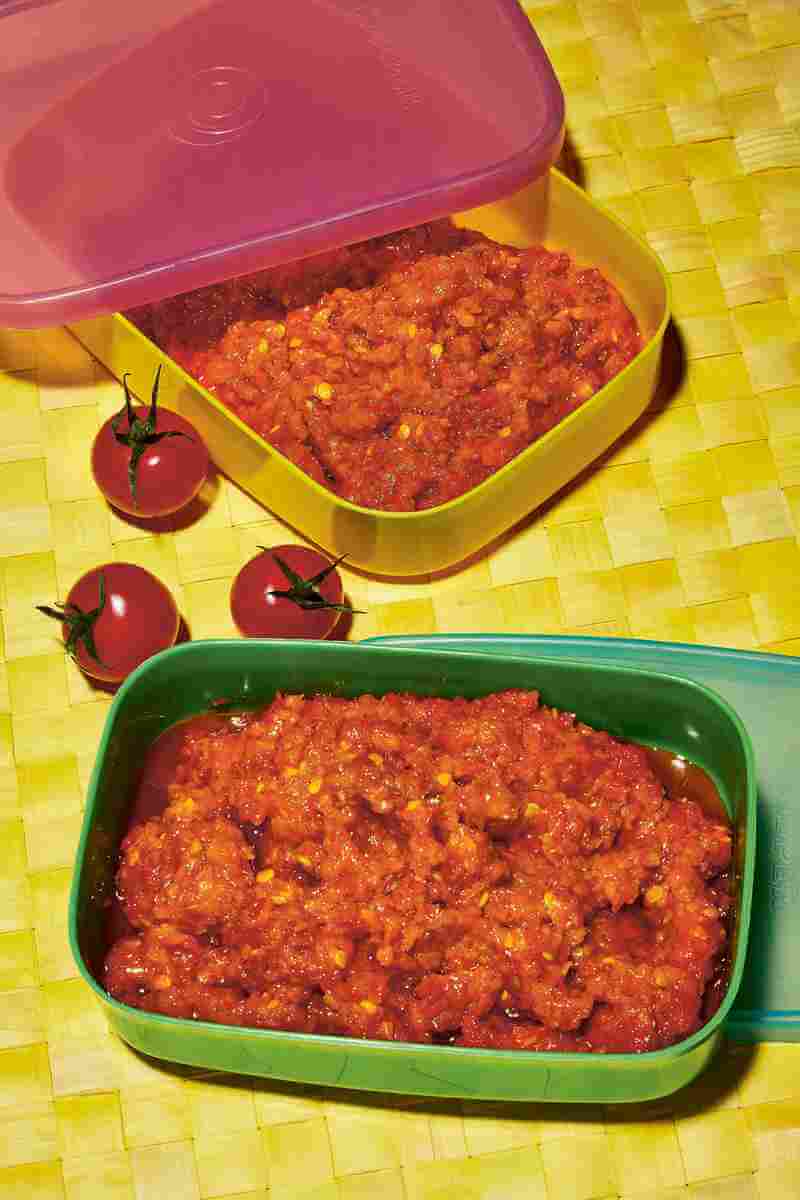
Enlarge this image
Sam Sifton is the founding editor of New York Times Cooking, and author of the No-Recipe Recipescookbook. We've invited him to play a game called "I don't need a recipe, I've got $1.50 in change." Three questions about the opposite of home cooking: vending machines.
Click the audio link above to find out how he does.

The Coronavirus Crisis Cooking During COVID-19: Family Meals And Fantasies Of Future Dinner Parties
PETER SAGAL, HOST:
And now the game where we ask people who are good at one thing to do something else. It's called Not My Job. Just about every night during the past year, I've considered just eating another frozen Hot Pocket. But then I say no. And I open up The New York Times Cooking app, and I read about amazing, delicious, easy-to-make recipes while I eat my Hot Pocket.
NEGIN FARSAD: (Laughter).
SAGAL: Sam Sifton is the creator and editor of New York Times Cooking. He has a new cookbook out called "No-Recipe Recipes."
Sam Sifton, welcome to WAIT WAIT... DON'T TELL ME.
(SOUNDBITE OF APPLAUSE SOUND EFFECT)
SAM SIFTON: Thank you for having me. It's a pleasure to be here.
SAGAL: One of the things that I was interested to find out is that you did not start with The New York Times, or really in journalism, as a food guy. You were, like, a news guy, right?
SIFTON: Well, I've done - one of the great things about being a journalist is it's a good job for people who have limited attention spans and issues with a story.
SAGAL: Right.
SIFTON: It's great to be able to go in and do lots of different things. I've worked on the food desk. I ran the culture desk. I ran the national desk. I was the restaurant critic. And now I'm hawking recipes.
MO ROCCA: Wow.
SAGAL: Just to go back to something - you were the restaurant critic for The New York Times. Isn't that, like, an incredibly feared position, where everybody was terrified of you coming into their restaurant without their knowledge and destroying them?
SIFTON: I certainly was trying to get into the restaurants without their knowledge. As you know, Peter, there are a lot of bald white guys in the world...
SAGAL: There are.
SIFTON: So it was a challenge sometimes to go unrecognized, but I gave it a shot. A little misdirection here or there, a little indirection - works every time.
SAGAL: And I say this because in addition to being a fan of New York Times Cooking, I love your newsletters. You send out an email just about every week saying, this is what you should cook this week. But it's always so kind and always so, like, oh, you know, you don't have to make anything fancy. You don't seem, what I'm trying to say, like the kind of guy who would be ready to go in and savage a restaurant. Did you ever have to do that?
SIFTON: Sure. You have to do it. And this is where visiting three or more times comes in handy because we don't savage a restaurant just on a whim. It's really bad. And I've spent hours and hours of time in the restaurant eating the bad food or experiencing the bad service or the combination of bad food, bad service, terrible decor. So you can kind of muster some energy, almost anger...
SAGAL: (Laughter).
SIFTON: ...Or righteous fury about it, and then you can get it done. But most of the time, I'm trying to be empathetic and kind and get you to cook more.
ROCCA: And you can tell, though, when the staff knows it's The New York Times restaurant reviewer because, sometimes, they catch on, and they get very nervous.
SIFTON: Or you can see the inexperienced waiter getting tackled by a manager.
(LAUGHTER)
SIFTON: Yes.
AMY DICKINSON: Sam, did you use a fake name to make reservations?
SIFTON: Oh, every time. It's like being Jason Bourne with absolutely no danger.
FARSAD: (Laughter).
SIFTON: You've got fake names, fake credit cards, the whole shebang.
SAGAL: Oh, yeah. Moving on to what you've been doing more lately, you created The New York Times - what do they call it? - The New York Times Cooking page, cooking site, cooking app. It's all those things. And from my perspective - I've been using it for some time - it's basically a very usable database of all the recipes The New York Times has ever published.
SIFTON: Most of them. I mean, we've been publishing recipes since the 19th century. This collects virtually everything back to the early 1980s. And...
SAGAL: Right.
SIFTON: ...It's - you know, I didn't create it. A whole giant team of incredibly talented people created it. I'm just the monkey at the front leading the band.
SAGAL: Right. And what's fun, by the way, is if you search for a particular ingredient, you'll get all the wonderful recipes made by your current cooks and contributors. But every now and then, it'll go back, and you'll get, like, a Pierre Franey from, like, 1970.
SIFTON: Yeah.
SAGAL: And it'll be, like, acquire three pounds of lard.
FARSAD: (Laughter).
SIFTON: Or even more terrifying - when you go back and discover there's, like, a microwave risotto recipe from sometime...
(LAUGHTER)
SIFTON: ...In the early '80s. They used science ovens then.
SAGAL: You published - your last cookbook was called, I think, "Sunday Dinner" (ph), where you put out the idea that you should always make a big dinner and invite your friends over on Sunday. It's a wonderful way to either end or start the week.
SIFTON: Yeah, it was called "See You On Sunday." It came out on February 25, so just a couple weeks before lockdown. And it was more than inviting over your friends and family. I explicitly said, invite strangers.
(LAUGHTER)
SIFTON: Get crowded. Get close together and enjoy these - welcome to...
ROCCA: Oh, Sam Sifton's superspreader (ph) cookbook.
(LAUGHTER)
SAGAL: OK. And so then we had the pandemic and the lockdown. And a year later, you publish a new cookbook just as everybody is saying, as soon as I'm out of here, I will never cook in this kitchen again.
(LAUGHTER)
SAGAL: For obvious reasons, more people, as we've been saying, have been cooking than have probably done so in a long time. So can I guess - because I know - you say you read every inquiry you get. Have you gotten any real helpless inquiries like, how exactly do you boil water?
SIFTON: (Laughter) Yeah.
SAGAL: Or what is a tablespoon?
SIFTON: Not quite what is a tablespoon, but we do get - amazingly, we do get notes that are sort of in the middle of the act of cooking. Someone takes to email to say, when will I know it's done?
SAGAL: (Laughter).
SIFTON: Urgent, urgent.
SAGAL: Urgent, urgent.
SIFTON: While I do...
SAGAL: It seems to be on fire. Is that correct?
SIFTON: (Laughter) And I can't answer that in real time. I read every letter sent, but not in real time.
SAGAL: What I really want to know - and this comes from the people on our staff who are frequent users of the New York Times Cooking site - if the recipe calls for a shallot, a single shallot, and you take the shallot, and you peel the shallot, and there are two bulbs in there, is that one shallot or two shallots?
SIFTON: Ah, it's an excellent question. First of all, it's one shallot still, even though it divides. But here's the wrinkle.
SAGAL: Yes.
SIFTON: Shallots are just getting bigger and bigger and bigger.
SAGAL: They are.
SIFTON: They're, like - shallots used to be kind of small, and now some shallots are the size of an onion. If a recipe calls for one shallot, and the shallot is the size of a soda can, that's too much shallot for this dish.
DICKINSON: This shallot conversation is, like, the most NPR thing I have ever witnessed in my life.
FARSAD: (Laughter).
SAGAL: No. Wait a minute. No.
DICKINSON: It's, like, wow.
SAGAL: You want to see that. Sam, what wine do you pair with...
(LAUGHTER)
SAGAL: Now it is.
SIFTON: Yeah. There you go.
SAGAL: Well, Sam Sifton, it's a pleasure to talk to you. I could ask you about cooking all day, but we've invited you here to play a game that this time we're calling...
BILL KURTIS: I Don't Need A Recipe. I've Got A Buck Fifty And Change.
SAGAL: We were wondering what the polar opposite of your kind of home cooking would be, and we came up with vending machines.
FARSAD: (Laughter).
SAGAL: Answer - talk about no recipes. Answer 2 out of 3 questions about vending machines - you will win our prize for one of our listeners - the voice of their choice on their voicemail. Bill, who is Sam Sifton playing for?
KURTIS: Dave Robinson of Portland, Ore.
SAGAL: OK. You ready for this?
SIFTON: I'm ready.
SAGAL: OK. Some date the vending machine back to ancient Greece, but most agree that the first modern mechanical vending machine appeared in London in 1822, in which it was used to sell what? A, raw oysters; B, dueling pistols; or C, banned books.
SIFTON: Wow. All right. So I'm going to take dueling pistols off the board. I'm a food guy. I'm going with oysters.
ROCCA: I think he's throwing away his shot, if you know what I mean.
SIFTON: Oh, gosh. All right. It's a gun. I can't believe that's the...
SAGAL: Which - now, I have to ask you, which is your - which is, I guess, your final answer?
SIFTON: Dueling pistols.
SAGAL: No, it was banned books.
SIFTON: What?
ROCCA: I'm so sorry, Sam.
SIFTON: Yeah.
FARSAD: (Laughter).
SIFTON: Mo, you let me down.
KURTIS: You were baited.
SAGAL: I was...
SIFTON: How can it be banned books?
SAGAL: It was basically - so there was this publisher who was trying to sell banned books that were politically dangerous. And he said to himself, I know. If I'm not selling them, but a machine is selling them...
SIFTON: I'm not really selling them.
SAGAL: Exactly. So they'll have to arrest the machine. It didn't work. You have two more chances here, Sam. This is not going to be a problem. Not all vending machines are successful. In fact, Coke had to apologize for creating a soda vending machine that did what? A, catch your hand in the door and then demand another buck and a half to let you go; B, made you say it's the real thing really loud before it would sell you a cola; or C, had a thermometer inside and charged you more if it was really hot out.
SIFTON: Well, never underestimate the thirst of Big Soda for profit...
SAGAL: Yes.
SIFTON: ...So temperature.
SAGAL: You're right.
(SOUNDBITE OF BELL)
SAGAL: That's what it was.
(SOUNDBITE OF APPLAUSE SOUND EFFECT)
FARSAD: Surge...
SAGAL: It seemed to make sense - you know, peak demand.
FARSAD: Surge selling.
SAGAL: All right. That means that if you get this last one, you win. People talk about the vending machine culture in Japan, but that's nothing next to the vending machines of Singapore. Which of these can you buy from a vending machine in Singapore? A, gold bars; B, mashed potatoes with gravy; or C, Ferrari sports cars.
SIFTON: Wow.
ROCCA: Wow.
SIFTON: Singapore - it seems entirely conceivable that all three are possible.
SAGAL: You're right.
(SOUNDBITE OF BELL)
SAGAL: They're all right.
FARSAD: Yay.
SAGAL: Bill, how did Sam Sifton do on our quiz?
KURTIS: Well, that means he won. He's a winner on this.
SAGAL: Congratulations.
KURTIS: Congratulations, Sam.
SIFTON: Thank you so much - thrilled to be here, thrilled to win.
SAGAL: Sam Sifton is an assistant managing editor of The New York Times and the creator of NYT Cooking. His new book, "No-Recipe Recipes," is available now. Sam Sifton, thank you so much for joining us on WAIT WAIT... DON'T TELL ME.
SIFTON: Thank you, Peter.
SAGAL: Thank you, Sam. And I'll see you in my inbox.
SIFTON: That you will.
(SOUNDBITE OF SONG, "DINNER TIME")
STAND HIGH PATROL: (Singing) I'm a hedonist. I love the good food. I'm in a good mood. Everything is cool. I'm a hedonist. I love the good food. I'm in a good mood. Everything is cool. Sunday morning...
SAGAL: In just a minute, Bill takes you to the cleaners. It's the Listener Limerick Challenge. Call 1-888-WAIT-WAIT to join us on the air. We'll be back in a minute with more of WAIT WAIT... DON'T TELL ME from NPR.
Copyright © 2021 NPR. All rights reserved. Visit our website terms of use and permissions pages at for further information.
NPR transcripts are created on a rush deadline by Verb8tm, Inc., an NPR contractor, and produced using a proprietary transcription process developed with NPR. This text may not be in its final form and may be updated or revised in the future. Accuracy and availability may vary. The authoritative record of NPR’s programming is the audio record.









